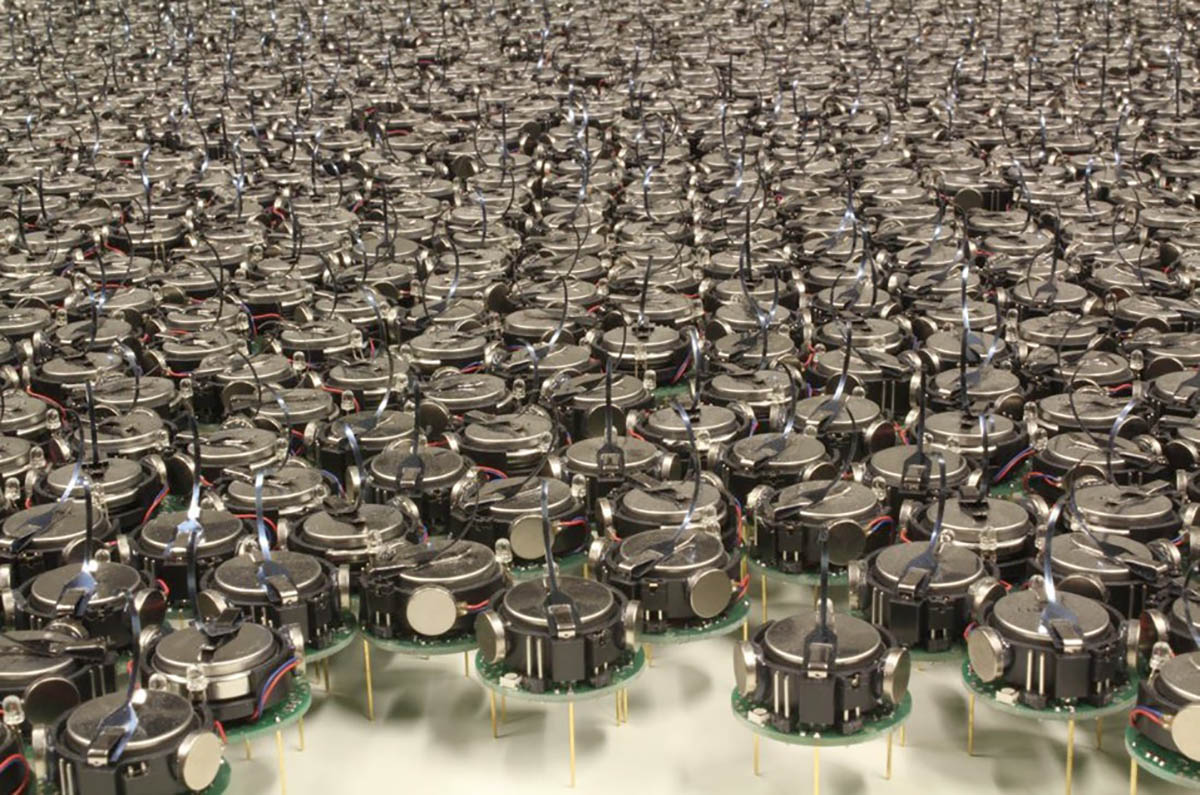Downloads
DOI:
https://doi.org/10.7480/spool.2017.1.1911Keywords:
Swarm robotics, self-organization, multi-agent systemsAbstract
Not only recent Science Fiction – e.g., Star Trek Beyond (USA 2016) – celebrates the capacities of robot collectives. Also RoboCup, an annual robot soccer competition, or Harvard University’s Kilobot Project show stunning examples of the central idea behind Swarm Robotics: »[U]sing swarms is the same as getting a bunch of small cheap dumb things to do the same job as an expensive smart thing« (Beni/Wang 1989). This article examines some crucial aspects of the techno-history of a research field which intertwines engineering and biological knowledge and whose applications deal with compelling questions about synchronization and self-organization in changing environments – on the ground, in the air, and under water.
How to Cite
Published
Issue
Section
Categories
License
Copyright (c) 2020 SPOOL

This work is licensed under a Creative Commons Attribution 4.0 International License.

References
Augugliaro, F., et al. (2013) ‘Building Tensile Structures with Flying Machines,’ (paper presented at IEEE/RSJ International Conference on Intelligent Robots and Systems (IROS) November 3-7)
Beni, G. (2008) ‘From Swarm Intelligence to Swarm Robotics,’ in: Swarm Robotics, ed. Erol Sahin and William M. Spears. New York: Springer, pp. 3–9
Beni, G. (2008). ‘Order by Disordered Action in Swarms’, in: Swarm Robotics, ed. Erol Sahin and William M. Spears. New York: Springer, pp. 153–172
Bonabeau, E., Dorigo, M., and Theraulaz, G. (1999). Swarm Intelligence. From Natural to Artificial Systems. New York: Oxford University Press
Brooks, R. A., and Flynn, A. M. (1989). ‘Fast, Cheap, and out of Control: A Robot Invasion of the Solar System,’ Journal of The British Interplanetary Society 42, pp. 478–485
Cabrera de Luis, A. (2012) ‘Collective transport in large swarms of simple robots’(MA thesis, Harvard University), https://www.eecs.harvard.edu/ssr/papers/epflmasters12-cabrera.pdf
Carranza, P., and Coates, P. (2000). ‘Swarm Modelling. The Use of Swarm Intelligence to Generate Architectural Form,’ http://www.generativeart.com/on/cic/2000/CARRANZA_COATES.HTM
Corner, J., and Lamont, G. (2004). ‘Parallel Simulation of UAV Swarm Scenarios,’ in Proceedings of the 2004 Winter Simulation Conference, ed. R. G. Ingalls, M. D. Rossetti, J. S. Smith, B. A. Peters, pp. 355–363
Ferdinandy, B., Bhattacharya, K., Ábel, D. and Vicsek, T. (2012). ‘Landing together: How flocks arrive at a coherent action in time and space in the presence of perturbations,’ Physica A 391, pp. 1207–1215
Groß, R., Bonani, M., Mondada, F., and Dorigo, M. (2006). ‘Autonomous Self-assembly in a Swarm-bot’, IEEE Transactions on Robotics 22/6, pp. 1115–1130
Helbing, D., and Johansson, A. (2009). ‘Pedestrian, Crowd and Evacuation Dynamics,’ in Encyclopedia of Complexity and Systems Science, ed. Robert A. Meyers. New York: Springer, pp. 6476–6495
Helbing, D., et. al. (2005). ‘Self-organized pedestrian crowd dynamics: Experiments, simulations, and design solution,’ Transportation Science 39/1, pp. 1–24
Kube, C. R., Zhang, H. (1993). ‘Collective Robotics: From Social Insects to Robots,’ Adaptive Behavior 2/2, pp. 189–219
Mammen, S. von, Jacob, C. (2008). ‘Swarm-Driven Idea Models – From Insect Nests to Modern Architecture’, WIT Transactions on Ecology and Environment 113, pp. 117–126
Nembrini, J., et al. (2005). ‘Mascarillion: Flying Swarm Intelligence for Architectural Research,’ http://infoscience.epfl.ch/record/50996
Oosterhuis, K.: ‘Swarm Architecture,’ http://www.oosterhuis.nl/quickstart/index.php?id=538
Petersen, K. (2014). ‘Collective Construction by Termite-Inspired Robots,’ (PhD thesis, Harvard University)
Rubenstein, M., Ahler, C., and Nagpal, R. (2012). ‘Kilobot: A Low Cost Scalable Robot System for Collective Behaviors,’ Proceedings of 2012 IEEE International Conference on Robotics and Automation
Sahin, E. (2008). ‘Swarm Robotics: From Sources of Inspiration to Domains of Application’, in: Swarm Robotics, ed. Erol Sahin and William M. Spears. New York: Springer, pp. 10–20
Trianni, V., Dorigo, M. (2006). ‘Self-Organisation and Communication in Groups of Simulated and Physical Robots,’ Biological Cybernetics 95/3, pp. 213–231
Vehlken, S. (2013) ‘Zootechnologies. Swarming as a Cultural Technique’, Theory, Culture and Society 30/6, Special issue Cultural Techniques, pp. 110–131
Vehlken, S. (2014). ‘Swarming. A Novel Cultural Technique for Generative Architecture,’ Footprint 15. Special Issue Data-Driven Design, ed. Henriette Bier, Terry Knight, pp. 9–17
Werfel, J., Petersen, K., and Nagpal, R. (2014). ‘Designing Collective Behavior in a Termite-Inspired Robot Construction Team’, Science 343, pp. 754–758
Willmann, J., et al. (2012). ‘Aerial Robotic Construction Towards a New Field of Architectural Research,’ International Journal of Architectural Computing 3/10, pp. 439–459
Zeng, Y., et. al. (2007). ‘SwarmArchitect. A Swarm Framework for Collaborative Construction’, in Proceedings of the 9th Annual Conference on Genetic and Evolutionary Computation, p. 186



